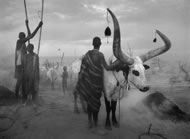One of the most revered photojournalists of our time, Brazilian-born photographer Sebastião Salgado is best known for his long-term documentary projects communicating global issues. Having previously studied economics, Salgado picked up a camera in the early 1970s and has been using his lens to illuminate the plight of people and of Nature ever since.
His work has highlighted scenes of oppression and exploitation, including pre-industrial labour in a supposedly post-industrial world. And whilst the communicative capabilities of his medium are more important to Salgado than artistic expression, nevertheless the aesthetic merit of his photographs has won high accolade and reputation as art.
For years Salgado has documented people on or near the margins of society, as well as the ‘archaeology’ of changes in the physical and psychological landscape brought about by the forces of modernisation, globalisation and capitalism. His prolific career has ranged from a major exhibition commissioned by the local council in La Courneuve, a Paris suburb, exposing the problems of accommodation and living conditions there, to the documentation of the effects of drought in the Sahel region of Africa, working with the humanitarian aid group Médecins Sans Frontières. Salgado’s reportage has covered the demise of large-scale manual labour across the globe in over 26 countries, and his portfolio of work includes 36 photographic investigations into global migration.
The debate that often surrounds Salgado’s work is whether it should be classified as documentary photography, photojournalism or fine art photography; some, such as the art historian and photographer Julian Stallabrass, have coined it ‘fine art photojournalism’. Despite differing definitions, there is no denying that it is a form of what some might call concerned photography.
Salgado’s upcoming exhibition at the Natural History Museum in London, entitled Genesis, is the culmination of an eight-year odyssey to capture the last wild places on the planet. Begun in 2004, and likely to be his last large-scale project, it aims to portray the undefiled and untarnished facets of Nature and humanity. It consists of a series of breathtaking black-and-white photographs portraying landscapes and wildlife, as well as human life that exists outside of mainstream society – communities still living in the grooves of cultural traditions and ancestral values.
A photographic philosopher’s stone exploring over 32 countries, Genesis offers insights into the potential for humanity’s rediscovery of itself in Nature. Being by definition about origins, explains Salgado, this project “is designed to reconnect us to how the world was before humanity altered it almost beyond recognition”. These images show us what has been lost, what could soon be lost, but also what has not yet been lost – what there still is to save and protect. Genesis proposes that “this uncontaminated world must be preserved and even expanded so that development is not automatically commensurate with its destruction”.
In previous projects such as Other Americas, Workers, and Migrations, although they do not focus on the environment, Salgado was continually confronted with the damaged and deteriorating relationship between Nature and humanity during their compilation. It is in Genesis that his growing desire to illuminate these environmental concerns is consummated, and with staggering beauty. From breathtaking images of whales flipping their tails out of the ocean, to extraordinary photographs of tribal peoples in the Omo Valley (Southern Ethiopia), Salgado forges imagery with heavenly light, sharp contrasts and his trademark dynamic composition as mainstays.
Salgado is an adventurer by nature as well as profession, and his exploits are something akin to ‘planetary anthropology’. He describes the exhilaration of being in the wilderness, doing exactly as you wish when you wish – destiny firmly placed in your hand. He talks of the overwhelming humility shown by people on his expeditions in the wilderness, such as the welcome and generosity of those he encountered on an 800km walk from Lalibela towards the Simien Mountains. Being on foot allows Salgado to compose magnificent perspectives and capture the wonderment he experiences.
As well as being a UNICEF Goodwill Ambassador, Salgado is dedicated to reforestation, conservation and environmental education. Since the 1990s, together with his wife Lélia he has contributed to the restoration of 1,500 acres of land in Brazil with the original species of the Atlantic Forest, part of which was successfully made into a nature reserve, the Instituto Terra. In addition to reforesting the land, the Instituto Terra provides practical education to municipal officials, teachers, farmers and students. “We believe”, says Salgado, “Instituto Terra is demonstrating that it is possible to turn back the clock and recover what seemed lost forever.”
A unique social conscience, Salgado has demonstrated his commitment to raising environmental awareness, using photography that goes beyond aesthetics, reaching out for engagement and compassion, touching our fundamental humanity. His vision has demonstrated the ability of powerful images to alter perception and interpretation – to view the world differently.
As Stallabrass once stated: “Photography, in particular, has a strong disposition to transform its images into memento mori.” Let’s hope that in years to come Sebastião Salgado’s photographs will not just be documents of a past world.
Sebastião Salgado’s exhibition Genesis runs from 11 April to 8 September 2013 at the Waterhouse Gallery, Natural History Museum, London. www.nhm.ac.uk







